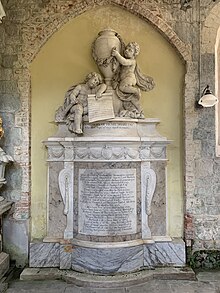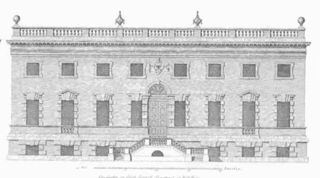

Henry Hoare II (1705–1785), known as Henry the Magnificent, was an English banker and garden owner-designer.


Henry Hoare II (1705–1785), known as Henry the Magnificent, was an English banker and garden owner-designer.
Henry's grandfather, Richard Hoare, was a goldsmith-banker and Lord Mayor of London. His father, Henry Hoare I, bought the ancestral estate of the Stourtons and built a Palladian villa designed by Colen Campbell. [1] When his father died, Henry Hoare II was 20 years old. He was educated at Westminster School. [2]
Henry dominated the Hoare family through his wealth and personal charisma. [2] He was a partner for nearly 60 years in Hoare's Bank. His nickname, "Henry The Magnificent", derived in part from his influence as a great patron of the Arts, but more particularly because he laid out the gardens at Stourhead in Wiltshire, an estate bought by his father. [3] In the thirty years after his mother died in 1741, he worked on the gardens at Stourhead, planning and planting what became a "masterpiece" of European garden design. In the 'school' of Poussin, it was said to be "more beautiful than any landscape put on canvas". [1] The gardens were admired as a showplace [4] and Capability Brown, the renowned landscape gardener, was well known to Henry. [5] In 1734 he was elected Member of Parliament for Salisbury. [6]
He died in 1785 leaving Stourhead to the son of his daughter Ann (1734–1759), Richard Colt Hoare. [7] His younger daughter, Susanna, became Countess of Ailesbury. [8]

Stourhead is a 1,072-hectare (2,650-acre) estate at the source of the River Stour in the southwest of the English county of Wiltshire, extending into Somerset. The estate is about 4 km northwest of the town of Mere and includes a Grade I listed 18th-century Neo-Palladian mansion, the village of Stourton, one of the most famous gardens in the English landscape garden style, farmland, and woodland. Stourhead has been part-owned by the National Trust since 1946.

Sir Richard Colt Hoare, 2nd Baronet was an English antiquarian, archaeologist, artist, and traveller of the 18th and 19th centuries, the first major figure in the detailed study of the history of his home county of Wiltshire.

Sir Richard Hoare was the founder of C. Hoare & Co, the oldest extant bank in the United Kingdom.

Colen Campbell was a pioneering Scottish architect and architectural writer, credited as a founder of the Georgian style. For most of his career, he resided in Italy and England. As well as his architectural designs he is known for Vitruvius Britannicus, three volumes of high-quality engravings showing the great houses of the time.

The English landscape garden, also called English landscape park or simply the English garden, is a style of "landscape" garden which emerged in England in the early 18th century, and spread across Europe, replacing the more formal, symmetrical French formal garden which had emerged in the 17th century as the principal gardening style of Europe. The English garden presented an idealized view of nature. Created and pioneered by William Kent and others, the “informal” garden style originated as a revolt against the architectural garden and drew inspiration from paintings of landscapes by Salvator Rosa, Claude Lorrain, and Nicolas Poussin.
C. Hoare & Co., also known as Hoares, is a British private bank, founded in 1672 by Sir Richard Hoare; it is currently owned and led by the eleventh generation of his direct descendants. It is the second oldest bank in the United Kingdom and reputedly the fifth oldest in the world.

Stourton with Gasper is a civil parish in the southwest of the English county of Wiltshire. Its main settlement is the village of Stourton, along with the hamlets of Bonham and Gasper. The village is about 2+1⁄2 miles (4 km) northwest of the small town of Mere, and is part of the Stourhead estate, which includes much of the west of the parish. The estate is in the ownership of the National Trust, and the entrance to the estate's famous house and garden is through the village.

Alfred's Tower is a folly in Somerset, England, on the edge of the border with Wiltshire, on the Stourhead estate. The tower stands on Kingsettle Hill and belongs to the National Trust. It is designated as a Grade I listed building.
Charles Arthur Richard Hoare was an English banker who became a senior partner in the private bank C. Hoare & Co. He was a keen amateur cricketer who played one first-class cricket match for Kent County Cricket Club.

Sir Henry Ainslie Hoare, 5th baronet DL was an English banker and Liberal politician who sat in the House of Commons between 1866 and 1874.

Philip Richard Fendall I (1734–1805) was an influential banker, lawyer, and merchant in Alexandria, Virginia. He was a member of the Lee family and a friend and business partner to George Washington. Fendall constructed the Lee-Fendall House on the corner of Washington and Oronoco Streets as a lasting home for his family.

Henry Hoare I (1677–1725), known as Good Henry, was an English banker and landowner.

Charles Hoare was Senior Partner of the banking firm of C. Hoare & Co
Sir Henry Hugh Arthur Hoare, 6th Baronet was an English landowner, best known for his restoration of the country house at Stourhead in Wiltshire, following a fire in April 1902. Prior to his death he donated the house and gardens to the National Trust.
Cutts Barton (1706–1780) D.D. was an English cleric, Dean of Bristol from 1763 to 1780.

Spridleston is an historic manor in the parish of Brixton in Devon, England, long a seat of a branch of the prominent and widespread Fortescue family. The ancient manor house does not survive, but it is believed to have occupied the site of the present Spriddlestone Barton, a small Georgian stuccoed house a few hundred yards from the larger Spriddlestone House, also a Georgian stuccoed house, both centred on the hamlet of Spriddlestone and near Higher Spriddlestone Farm.

Sir Henry Hugh Hoare, 3rd Baronet (1762–1841) was an English banker, a partner in Hoare's Bank, with a particular interest in the affairs of the Church of England.
Henry Hoare (1807–1866) was an English banker, a partner in Hoare's Bank. One of numerous family members of the name, he is called Henry Hoare of Staplehurst, after his Kent estate. He is now known as a lay activist for the Church of England, particularly concerned with the revival of Convocation, dormant since the early 18th century.

Henry Hoare of Mitcham Grove (1750–1828) was an English banker, senior partner of Hoare's Bank over four decades.

Sir Hugh Richard Hoare, 4th Baronet was an English banker, a partner in Hoare's Bank.